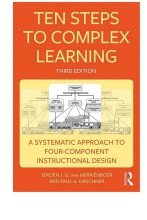Summary: Ten Steps To Complex Learning A Systematic Approach To Four-Component Instructional Design | 9781351624350 | Jeroen J G van Merriënboer, et al
- This + 400k other summaries
- A unique study and practice tool
- Never study anything twice again
- Get the grades you hope for
- 100% sure, 100% understanding
Read the summary and the most important questions on Ten Steps to Complex Learning A Systematic Approach to Four-Component Instructional Design | 9781351624350 | Jeroen J. G. van Merriënboer; Paul A. Kirschner
-
2 Four blueprint components
-
2.1 Training blueprints
This is a preview. There are 4 more flashcards available for chapter 2.1
Show more cards here -
Whole-task experiences based on real-life tasks and situations that aim at integrating knowlegde, skills and attitudes are called:
Learning tasks -
Information that is helpful for learning and performing the problem-solving, reasoning and decision-making aspects of learning tasks is called:
Supportive information -
Information prerequisite for learning and performing routine aspects of learning tasks is called:
Procedural information -
Practise items provided to help learners reach a very high level of automaticity for selected routine aspects of a task are called:
Part-task practice -
2.2 Preventing compartimentalization
This is a preview. There are 1 more flashcards available for chapter 2.2
Show more cards here -
What is inductive learning?
A process in which learners induce knowledge from concrete experiences (constructing schema's) -
According to the model, one must have variability of practice between learning tasks. What is meant by variability of practice?
Learning tasks that differ from each other on all dimensions on which tasks also differ in the real world -
What does variability of practice look like in the schematic blueprint?
Little triangles placed at different positions in the learning tasks -
2.3 Avoiding fragmentation
This is a preview. There are 4 more flashcards available for chapter 2.3
Show more cards here -
In the schematic blueprint, task classes look like:
Dotted boxes around the learning tasks -
What is the difference between support and guidance?
(Task) support is product-oriented (how to get to the goal)
Guidance focuses on the process -
What is the name for a learning task with the highest possible support?
A case study
- Higher grades + faster learning
- Never study anything twice
- 100% sure, 100% understanding
Topics related to Summary: Ten Steps To Complex Learning A Systematic Approach To Four-Component Instructional Design
-
Four blueprint components - Dealing with the transfer paradox
-
Ten Steps
-
Step 1: design learning tasks - Real and simulated task environments
-
Step 1: design learning tasks - Built-in task support
-
Step 2: design performance assesments - Skill Decomposition
-
Step 2: design performance assesments - Formulating performance objectives
-
Step 4: Design Supportive Information - Providing SAPs and Domain Models
-
Step 4: Design Supportive Information - Summary of guidelines
-
Step 7: design procedural information
































